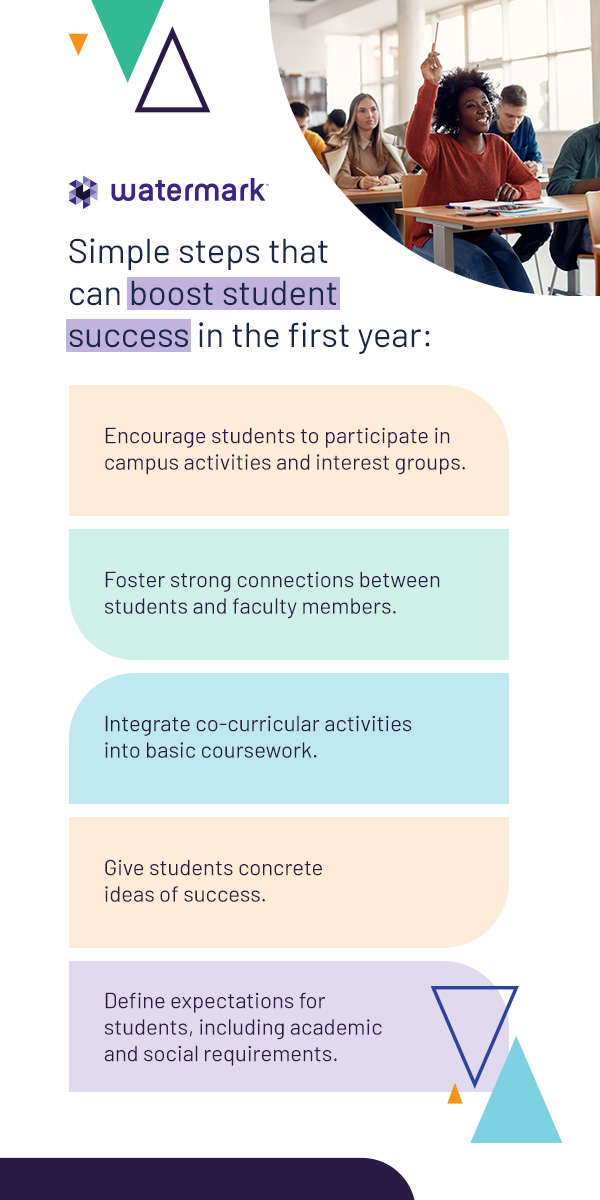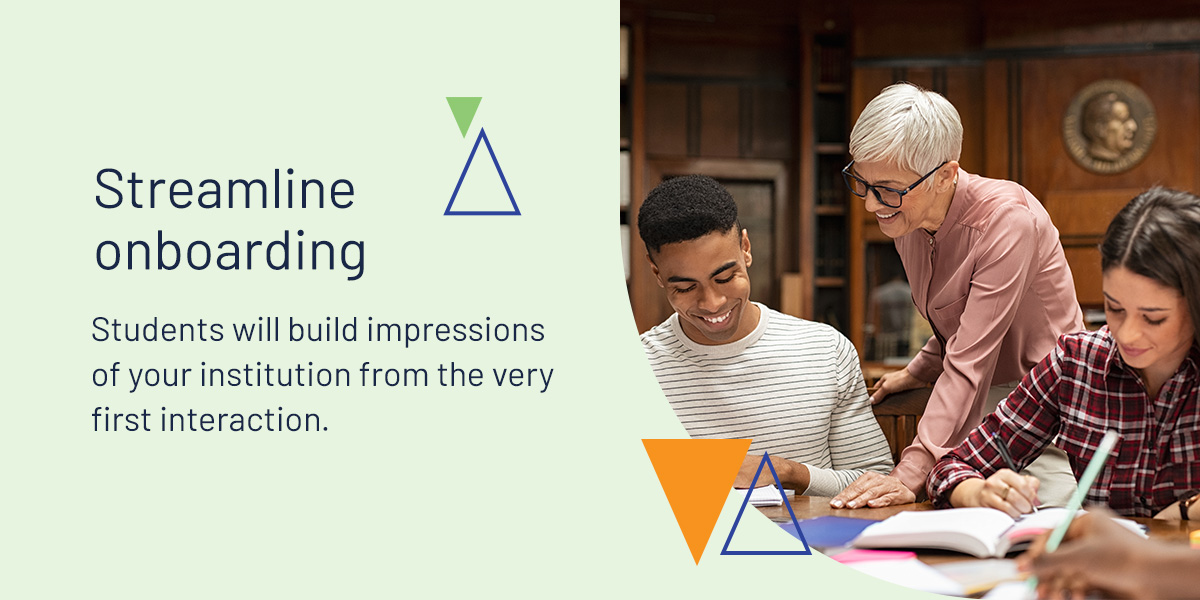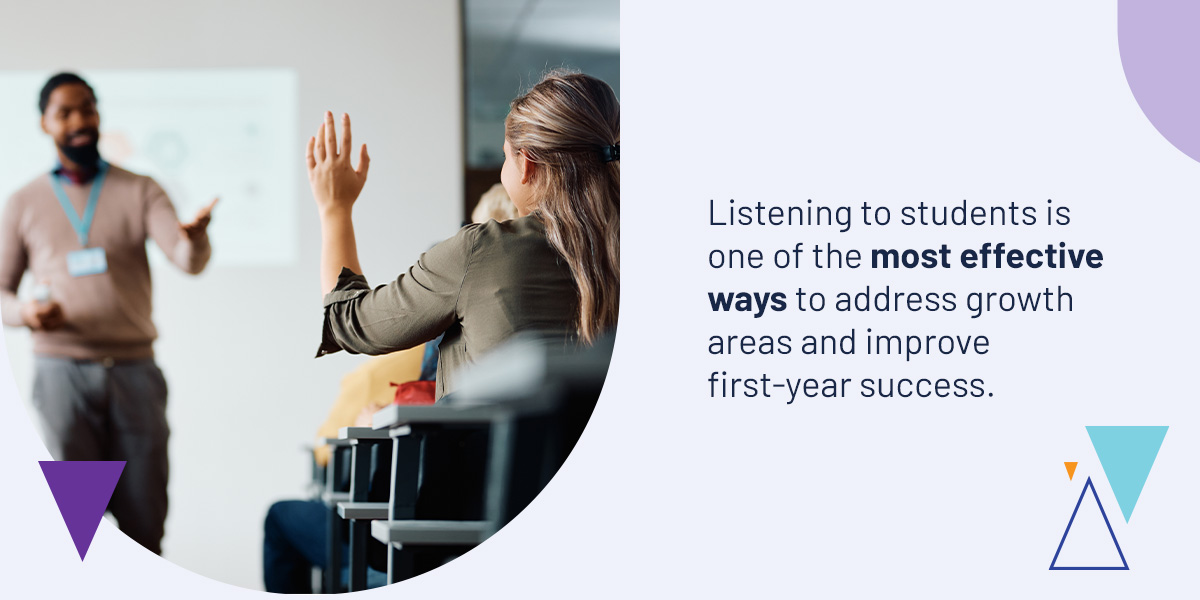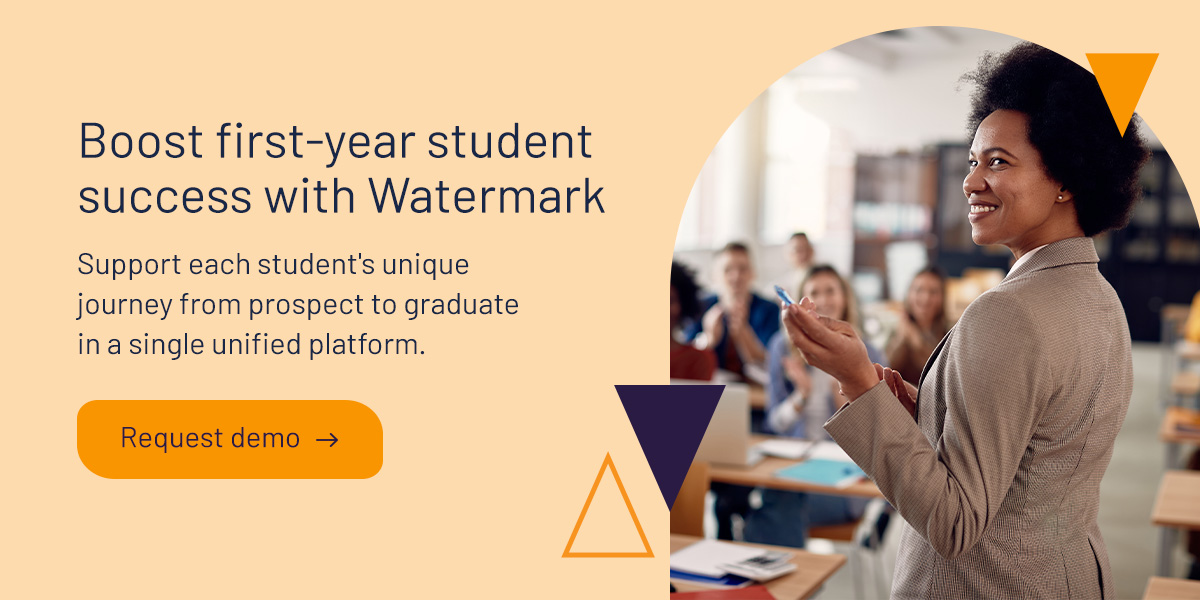



Student retention is one the biggest challenges for higher education institutions, and none more than the first year of college. About 25 percent of first-year college students don’t return to any school for their second year and another 35 percent return to different schools. Student success depends on more than academic resources. It requires a holistic approach that meets students where they are and supports them when necessary.
Understanding how to improve first-year student performance is essential for institutions wanting to boost retention and see students through graduation. Many of the necessary strategies involve engaging students and encouraging integration into campus culture. Higher education professionals can successfully boost performance by placing the student at the center of every retention and support strategy.
Higher education is a massive transition, especially for first-generation college students. Even the most prepared student will likely experience a slight culture shock. Sometimes, that can affect college freshman student performance. However, it’s not the only factor that can derail students in their first year. Once the downward spiral begins, students become increasingly demotivated, and retention becomes increasingly challenging.
Much of first-year student success depends on their ability to engage in their new academic journey. Some of the many factors that influence student performance in the first year include:
The link between student success and retention is more complex than failing. Academically strong students have many other reasons for dropping out. Institutions that address these reasons can intervene and retain many of these students, provided they can find and correct the root of the issue. Some of the common challenges facing student retention in the first year include:
Regardless of the individual student and their reasons for dropping out, first-year programs can significantly influence student success and retention. Engaging academic and student support programs can make students more persistent and successful in their first year. Students who develop a sense of belonging often have a better chance of success academically, cultivating a connection with the institution. This connection makes them more likely to persist in the face of challenges.
Without intervention, this result is even more likely. When retention is low in the first year, higher education institutions can identify patterns in retention rates and deal with any shortfalls. When pinpointing areas where they fall short, they can provide students with the support they need to keep them enrolled.
Institutions can do much in the first year of college to boost student success and retention, including:
Students who drop out often feel a disconnect on campus. They might lack confidence or doubt whether they can meet academic expectations for a variety of reasons. Successful students have a sense of connection to every aspect of the institution, from the faculty to their classmates. One common thread is a positive outlook. These students have clear goals that align with their connection to the institution.
Many students enter their first year with a vague idea of success. They may lack specific objectives or assume they can proceed in a vacuum without involvement in campus activities. At some institutions, this approach may be enough. Others have a strong sense of community, and success is defined by all-round involvement.
As an institution, you can foster these positive connections with your students. Some simple steps can boost student success in the first year:
The more students know, the better they can set goals and stay on course. When you can clearly define these expectations, students can take the necessary steps to achieve success.
Many students drop out for reasons other than academic performance. Life challenges are prevalent for first-year students. Students may not be aware of the support resources your campus offers. They may not understand how to access them if they know about them. You can address student success proactively by offering these resources and streamlining the path for students to access them.
Your strategy can be as simple as directing students to the right buildings. The best approach is to remove friction for students as they learn their way around campus. Interactive maps can be beneficial. You can also communicate with students, encouraging them to take advantage of tutoring, mental health, athletic, and health services.
Past data on student performance is one of your most valuable assets in tackling success and retention challenges. Every higher education institution generates massive amounts of data. The key to leveraging this data is to understand how it works. When you understand analytics, you can leverage your existing data to get valuable insights into:
Students will build impressions of your institution from the very first interaction. The first few months have a significant impact on their overall success. They should feel completely comfortable when facing challenges, knowing who to consult and where to get support.
Many successful institutions connect students to a dedicated advisor who introduces them to campus services. These advisors are responsible for giving students the information they need to succeed. Students should have access to their advisors and resources before they set foot on campus for the first time.
First-year and first-generation students should have a robust onboarding process, virtually and in person. The more they can learn about campus services and academic expectations, the better. Onboarding events like meet-and-greets allow them to connect and develop the necessary bonds with their educational community.
Onboarding is only successful when backed by a robust first-year experience. It should be a taste of what’s to come, not the highlight of the first year. The student experience should connect them with a supportive and familiar community, complete with close relationships. Plan your experiences to engage students where they are and provide maximum impact.
With the data you have at your disposal, you can introduce new initiatives to the needs of students with each passing year. You can keep what works and improve on what doesn’t, fostering a culture of growth throughout your institution. Creating the best possible first-year experience also unites your faculty and administration. You can collaborate to meet new challenges by investigating the current first-year experience. You can experiment with new ideas to boost student success and retention.
Students quickly become disheartened when faced with complicated degree requirements, roadblock courses, and unavailable classes. They may have a clear goal and still be met with steep barriers to entry that often seem nonsensical. If these obstacles make sense from a pedagogical standpoint, they may still have a place at your institution. If not, change is the best possible solution.
Any higher education places student success at the heart of their efforts. Many have evolved to meet students where they are, offering accessible courses and simplifying degree requirements. While this change often starts on the administrative side, it filters through every part of your institution. The classroom experience is one of the most important. Students who feel their classes are relevant and engaging and that the faculty cares about their success are more likely to invest in their long-term success.
Finances are one of the main reasons students abandon their studies. A massive 42 percent of college dropouts named finances the primary reason for their decision. Institutions can combat this statistic with a proactive financial assistance and literacy approach. The more students know about available scholarships and job opportunities, the more empowered they are to continue their studies.
Providing emergency financial assistance is only half of the battle. Students need to know about it and understand how to access it. Provide opportunities for students in their first year to engage in financial literacy conversations and classes so that they feel confident about addressing financial issues. The more you empower them to take control of their financial future, the more impactful the long-term benefits.
Listening to students is one of the most effective ways to address growth areas and improve first-year success. Give them opportunities to provide feedback using the following avenues:
Understanding what students need to succeed is transformative, but this is where feedback begins. It’s a two-way street, and first-year students from various educational backgrounds often need regular feedback to remain engaged and adjust their expectations. Straightforward, actionable guidance prevents feelings of isolation and protects them from falling behind without realizing it. Use data-informed advising to measure success, identify at-risk students, and intervene at the right time.
Most students enroll in higher education to pursue a fulfilling career. Maintaining the connection between their studies and this goal is essential for engaged and motivated graduates. Connecting career goals and academic requirements early on in the college experience prepares them for their studies and incentivizes them to persist through challenges.
Provide students with career information and outline the opportunities related to each major. Introduce them to alumni who graduated with the relevant majors and supplement the academic experience with skills workshops. They offer in-demand skills and assign them career counselors to maintain the association between studies and future successes.
The first year of college is a challenging time for many students. They’re often on their own for the first time, adjusting to adult life while trying to stay on top of their studies. When challenges arise, they often need help figuring out where or how to seek assistance. Vulnerable students may slip through the cracks. Adjust your communication efforts to go beyond newsletters and meet students where they are on this new journey.
Put systems in place for advisors and faculty members to check in regularly with students. You can assign someone in the dorms to connect with new students and help them through first-year challenges.
Mental health is a challenge on many college campuses, with 60 percent of college students struggling with depression, anxiety, and other mental health disorders. These challenges can become overwhelming, and students may choose to drop out altogether. When you remove the stigma of mental health challenges and encourage students to take advantage of counseling and support groups, they’re empowered to continue with their studies.
You can also offer classes and seminars on mental health, giving students the tools to manage their mental health effectively. Again, students can also participate in these activities if they know about them. Promote your programs and draw attention to frictionless sign-ups and free services. The easier you make it for students to participate, the more likely they will seek help when needed.
You can often identify students who are likely to struggle early on. Your faculty or administration may report those students dealing with challenges at home, academically, or with their mental health. The earlier you can identify these students and their challenges, the more impactful your intervention will be. For example, if a student is struggling with mental health, you can connect them with the right resources.
Reports from your staff are instrumental in identifying at-risk students, but they are not infallible. Relying on observation alone might mean that some students slip through the cracks. Using current student data can help you identify these students in real time and connect them with the relevant resources. Intervention at the right time can mean the difference between retention and dropping out.
First-year student performance and the associated dropout rates are significant challenges for higher education institutions seeking to enhance student success. However, your institution can tackle these challenges with data-enhanced engagement and support strategies, making the most significant impact early on in the academic journey of each student.
With Watermark Student Success & Engagement, you can identify students most likely to drop out and intervene at the right time. Support each student’s unique journey from prospect to graduate in a single unified platform and get early alerts when students veer off course so that you can take decisive action. Request a demo of our student success solution and boost first-year retention with Watermark today!






























































































































































































































































































































































































Submit this form to schedule a meeting with one of our reps to learn more about our solutions. If you need customer support instead, click here.



